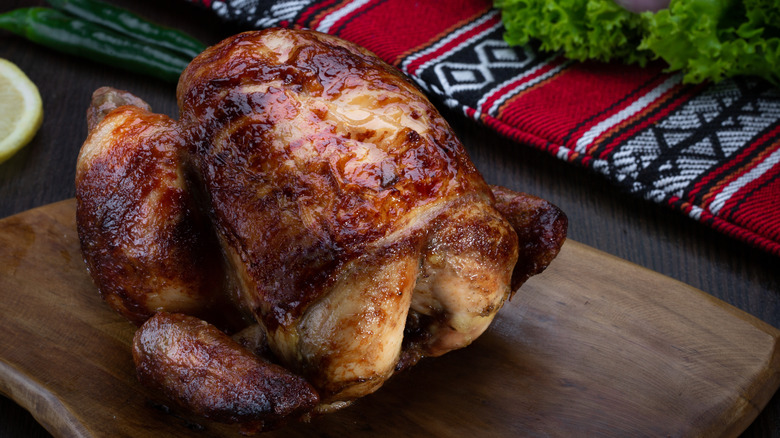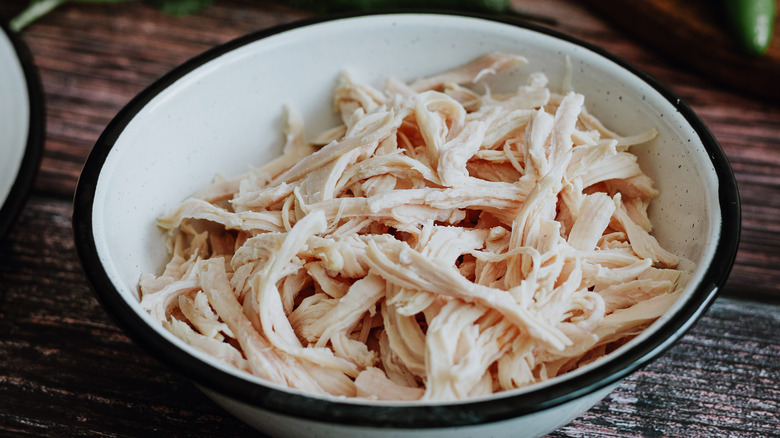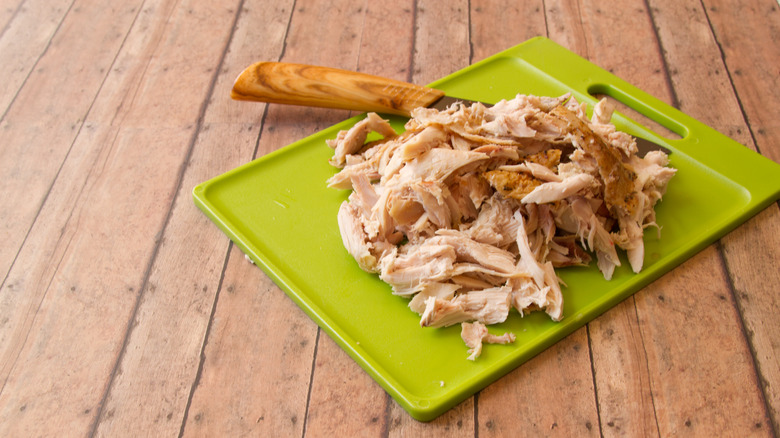How To Properly Freeze That Leftover Rotisserie Chicken
The only thing that might be more convenient than picking up a rotisserie chicken from the grocery store is already having one at home. They're perfect for serving up a roast chicken dinner, but they're also great for breaking down and using for all kinds of meal ideas. Use the carcass for stock and the shredded pieces for anything from sandwiches — whole or mixed into a quick and easy chicken salad — to tacos, pasta, or to top a loaded baked potato. It's so versatile, in fact, that you might find yourself tempted to pick up a few rotisserie chickens at once, and you absolutely should, as they freeze well.
While you can theoretically freeze a whole rotisserie chicken by letting it cool completely, wrapping it, and popping it into the freezer, we don't recommend that for a few reasons. For starters, getting all the air out of the storage bag will be more challenging, which increases the chances of freezer burn. Shredded chicken or a chicken that's been broken down into pieces is also easier to thaw and use.
Rotisserie chickens are all about convenience, after all, so it makes sense that the best way to freeze them is the most convenient. Breaking up a warm chicken might add some work in the beginning, but trust us when we say that your future self will thank you. With that in mind, let's talk about the best way to freeze and use those oh-so-handy rotisserie chickens.
Break your rotisserie chicken down before freezing
So, you've brought home a rotisserie chicken to freeze for later, or you're looking at freezing the leftovers. We recommend taking the time to divide the chicken into whole components or shredding it. Why? Breaking down the chicken will make it easier to get the air out of the freezer bag, helping to ensure the chicken remains moist and juicy when it's thawed and reheated.
You can opt to break the chicken down into pieces, separating the wings, legs, and breasts from the carcass. (If you want to truly get the most out of your purchase, use that carcass to make a basic chicken stock that can also be frozen for later use.) Use plastic wrap to wrap each piece so it's airtight, which will allow you to freeze the pieces in a single Ziploc bag and easily remove each piece when you're ready to use it.
You can also shred all the meat from the chicken, which is perfect if you're planning on using it for soup or stew. It's much easier if you do this when your chicken is still warm. However, you need to be careful to ensure the meat cools completely before freezing. Never put warm food in the freezer: Even that brief change in temperature can defrost adjacent foods, and that's the sort of thing that leads to the development of bacteria and, in turn, food poisoning.
Here's how to thaw and use your rotisserie chicken
When frozen properly, chicken can be kept indefinitely. (That is, of course, assuming that it remains frozen.) While it's technically fine to eat long after freezing it, it might not have the same quality you remember, so you still might want to date your packages and use them within the year. Once your chicken is thawed, you'll have to use it or lose it — which is one reason we recommend freezing shredded portions or whole but individually-wrapped pieces.
Thawing is easy, especially if you plan ahead: Just leave what you want to use in the fridge overnight. If dinner turns into a last-minute scramble, you can still safely thaw your chicken in a few hours. Leave it sitting out in some cold water, and it'll be ready to use in hot or cold dishes.
Start freezing rotisserie chickens on a regular basis, and you might find that this is when they really shine — particularly on those days when you don't feel like cooking a hot meal, but you're still craving something delicious. Use on top of salads or grain bowls, add to a wrap with your favorite greens and dressing, make a sandwich, or go for an open-faced sandwich alongside some avocado, pickled onions, and tomato. It's great in an almost infinite number of hot dishes, too: We'd recommend some salsa verde green chicken enchiladas or a sheet-pan chicken teriyaki.


